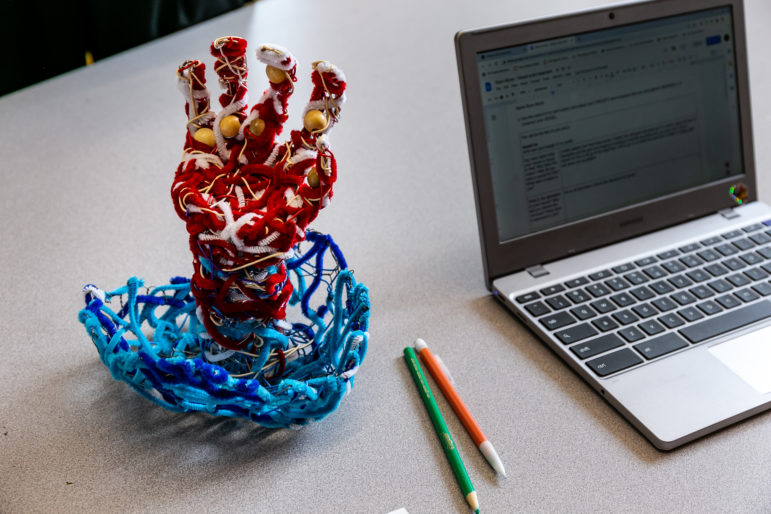“The arts are a form of embodied play that surpasses verbal processing and allows us to explore, connect with ourselves and others, and ultimately build or rebuild the muscles of imagination when life circumstances or the experience of trauma has taken them away.”

Adi Talwar
A student-created work at Bronx Community Charter School.In May, 19 students were shot to death in Texas in their own classroom and an 11-year-old was killed by a stray bullet in The Bronx. Gun violence is plaguing our city—and our nation—while our students suffer through the impact that trauma can inflict on their young, developing brains.
Fortunately, we have a powerful and underutilized tool right at our fingertips to help our students heal and process the world around them: arts education. That’s why I—a licensed Creative Arts and Registered Drama Therapist—am part of the movement to push New York City to guarantee arts funding student in the city’s budget.
Here’s why: for some students who are prone to mental health challenges or violence due to past life experiences, access to mental health support like arts therapy is a literal matter of life or death. Children who are exposed to traumatic events also often experience an array of after effects that can include emotional distress, difficulty with behavioral and affect regulation, trouble with building and struggles in school and illness. Traumatic stress can impair the development of the brain and nervous system. But students who partake in creative arts—like dancing, drama, creative writing, and painting—are able to rebuild neural pathways that might have been stunned from past trauma.
The arts work by integrating both sides of the brain. When we balance verbal and nonverbal processes we can then support neural integration and reduce stress. This is how the creative arts literally changes the make-up of the brain. The arts are a form of embodied play that surpasses verbal processing and allows us to explore, connect with ourselves and others, and ultimately build or rebuild the muscles of imagination when life circumstances or the experience of trauma has taken them away.
In my work, I know that drama therapy offers an innovative way for people to access and work through their trauma. Besides allowing our imagination muscles to form, we are giving space for people to connect with their own sense of play and spontaneity, loosening the ties of anxiety and creating space for emotional well-being. Just recently, in my drama therapy group with middle schoolers, we were exploring the theme of building community after being online for almost a year and a half. The students were asked to come up with a list of places where people might gather and then to choose one where we would create our scene. Through this play, students explored themes of existence, loneliness, and truth. As the scene ended, students spoke about their own personal fears and truths and reflected on the process of coming together to create the scene. The metaphor and the act of playing helped the students find another way in to explore and shift the stuckness they were feeling in their real life.
Teaching artists, teachers and creative arts therapists are front line workers. If the city can arm them with arts, perhaps they have a fighting chance to help the kids who are struggling in front of them. Trauma-aware arts practices help children connect their minds and bodies and integrate their lived experiences from a safe distance, using the metaphor that the art provides.
I hope the City Council and Adams Administration prioritize students and their mental health by guaranteeing adequate funding per student for arts. When children are given the opportunity to process through the arts they are better able to regulate their emotions and ultimately their behaviors, and are more likely to be able to take in lessons in the classroom. And while there is much quantitative data on how the arts support students, learning the qualitative data is just as important.
In my classes, the moment of eye contact, the shift in body language and the smiling eyes—even behind a mask—show just how much better mental health can start with the arts.
Heidi Landis is a licensed Creative Arts Therapist and Registered Drama Therapist in New York City.
City Limits’ series on the people, places and politics of New York City’s five-borough art scene is supported by the Laurie M. Tisch Illumination Fund.








